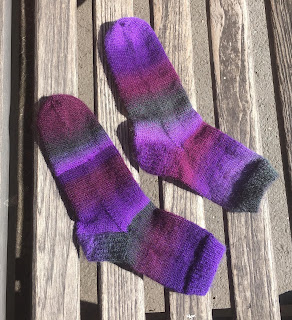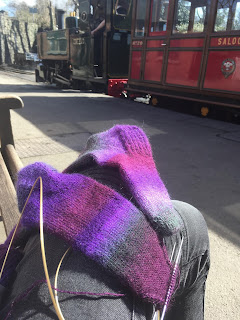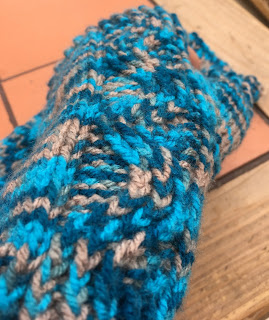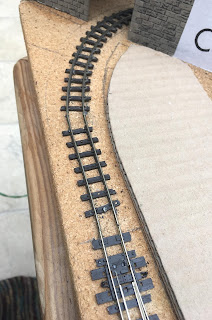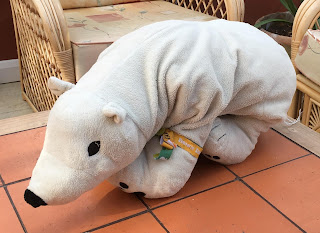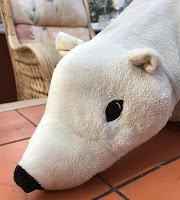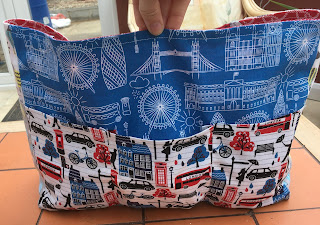 I've seen a few bags designed for keeping knitting and various other projects in, and they seem nice and useful. So I decided that I would try and make one for myself. I already had a couple of fat quarter packs that I wanted to use for something nice, and this seemed like a good thing to use them for.
I've seen a few bags designed for keeping knitting and various other projects in, and they seem nice and useful. So I decided that I would try and make one for myself. I already had a couple of fat quarter packs that I wanted to use for something nice, and this seemed like a good thing to use them for.The fat quarter packs were mostly travel related, one pack being London themed and the other one being nautical themed, there was another one with some hot air balloons on it, which I used as well. I think overall I used 9 fat quarters, which is less than two standard packs, but I did pick and choose what I wanted to go on the bag.
 |
| New Dimentions |
I sat and worked out what pockets I wanted and how to piece it all together, which, of course meant more technical drawings! ;)
Once the drawings were all done I drew out the panels real size on some old news paper, cut them out and used them as the pattern pieces, which were then folded up, put in an envelope and saved for next time.
The bag has a lining and I had to work out how to sew that together with the outside, in a way that didn't leave seams poking out on the inside, and I managed to suss it out. It did involve sewing a top stitch around the top of the bag to sew up the small hole that I left for turning it the right way out, but I think it looks good.
 The pockets took a little thinking about, but there wasn't going to be a lining for the pocket, so it was easier than the main bag. The pockets were sewn into the main seams of the bag, and had a small turned over and top stitched edge along the top.
The pockets took a little thinking about, but there wasn't going to be a lining for the pocket, so it was easier than the main bag. The pockets were sewn into the main seams of the bag, and had a small turned over and top stitched edge along the top.There are three pockets along the front, but none on the back. I wanted a difference to the front and back of my bag, but it would be easy to add more if you wanted to.
One thing I did do, which I wish I had done differently, is to make the front three pockets out of one piece of fabric, instead of trying to make it out of three... It ended badly, and they are a little wonky, but don't look too close...
 The two sides are exactly the same, they are a panel with a pocket in them. The side pockets were easier to do, and involved sewing a hem along the top of the pocket and sewing them into the main bag seams. They worked out well.
The two sides are exactly the same, they are a panel with a pocket in them. The side pockets were easier to do, and involved sewing a hem along the top of the pocket and sewing them into the main bag seams. They worked out well.There is a separate panel for the bottom piece, which gives the bag a fair amount of width, and I made it out of the same material as the handles. Which were folded over and sewn as a tube, and the ends folded inwards before I attached them to the bag.
When sewing the handles on I took a long time carefully sewing a neat square. It can be seen from both sides so I did worry about it, and whilst I used my sewing machine, I only hand cranked it, and went very slowly.
All in all I'm quite pleased with my bag, and seeing as it is one thing that I really made from the first ideas to the actual real thing, I am a little proud. One thing that I think would make it better is to add some kind of interfacing. The bag is a little floppy, its strong enough to hold all my projects (and carted a few waistcoats in making up to Tywyn to do some of that while I was there), but the interfacing would add a little bit of rigidity to the bag.
 I am happy to share the pattern I have made with other people. So if you are interested, do send me a message, and I can send you some drawings of the pattern pieces you need and write up some instructions. I have also recently got a facebook page, linked to the instagram page, which you can contact me on, and see what it going on more frequently then a finished project once a week. You can find the facebook page under the name Lemmon Juicer, and the handle on instagram is @lemmonjuicer - go have a look and feel free to like and comment on there.
I am happy to share the pattern I have made with other people. So if you are interested, do send me a message, and I can send you some drawings of the pattern pieces you need and write up some instructions. I have also recently got a facebook page, linked to the instagram page, which you can contact me on, and see what it going on more frequently then a finished project once a week. You can find the facebook page under the name Lemmon Juicer, and the handle on instagram is @lemmonjuicer - go have a look and feel free to like and comment on there.

